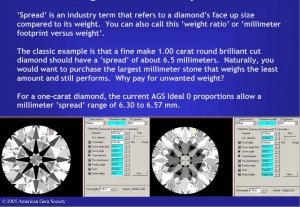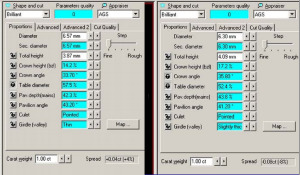- Joined
- Aug 14, 2009
- Messages
- 27,259
pfunk|1434460391|3889833 said:Yssie|1434401723|3889575 said:pfunk|1434398636|3889557 said:I guess I am still not completely understanding the weight ratio thing so if someone could help me out a little. What it sounds like to me is that AGS uses a standard tolk proportioned model with a set girdle thickness to determine what the diameter of an ideal diamond SHOULD be based upon its carat weight. What I don't get is what they mean by a 5% spread factor. Does that mean that the actual diameter needs to simply be within 5% of the "ideal" diameter? If so, does that mean either 5% larger OR 5% smaller than predicted is ok, or does that mean 2.5% on either side of what is "ideal"? Maybe you can use stone #1 as example? What was its carat weight (sorry if you already mentioned it)?
What is the "ideal" size for a 1 carat (6.47 mm I think?), 1.5 carat, and 2 carat stone based on the AGS tolk model stone?
http://www.pricescope.com/wiki/diamonds/ags-ideal-cut-diamond
Spread: For rounds the DiamCalc factor should must be within + or -5% about 6.35 to 6.6mm for a 1.00ct stone. Princess spread factors should not be worse than -25, or about 5.3mm square.
The numbers aren't making sense to me. If the 1.00 carat tolk normalized stone has a diameter of 6.47 mm, 5% of that diameter would be 0.324 mm. That would leave the +/-5% range at 6.15 to 6.79 mm which is a much larger range than 6.35 to 6.6mm. That's what is confusing me.
It's not a direct percentage of diameter - it's a +/- of carat weight as calculated by DC for a given diameter, "normalised" to a Tolk type "ideal" in terms of proportions. That was a muddy mouthful... Here's a summary:
Awesome Stone 1 has table T_Tolk, crown C_Tolk, pavilion P_Tolk, culet Cu_Tolk, Girdle G_Tolk, other important proportions O_Tolk, and diameter D = 6.47mm. This stone is the standard for comparison.
Not Awesome (steep/deep) Stone 2 has table T', crown C', pavilion P', culet Cu', Girdle G', other important proportions O', and diameter D'.
Imagine a hypothetical Awesome Stone 3 that had table T_Tolk, crown C_Tolk, pavilion P_Tolk, culet Cu_Tolk, Girdle G_Tolk, other important proportions O_Tolk, and diameter D'; this stone would weigh X.
Now, how much less than X does Not Awesome Stone 2 weigh? That's the difference we're interested in.
Here's an article from AGSL that illustrates this:
http://www.agslab.com/members/content/docs/Complete_Explanation_of_AGS_Cut_System.pdf (pg49)


Garry's patent also introduces details of spread: https://www.google.com/patents/US20020052170



300x240.png)